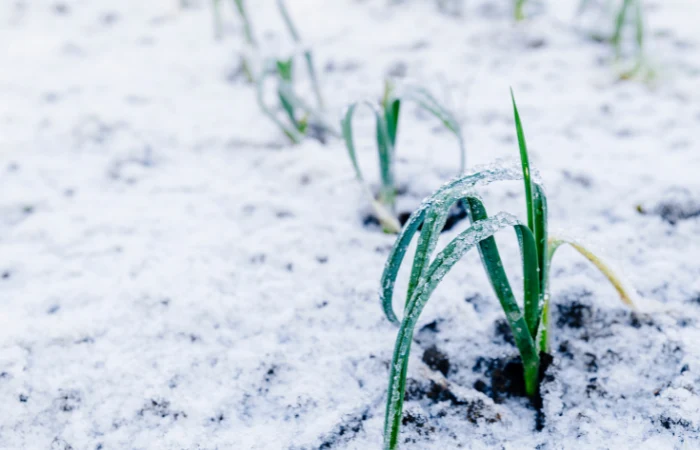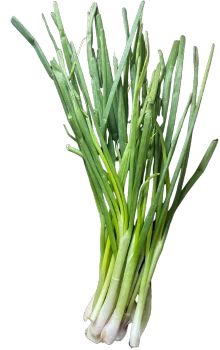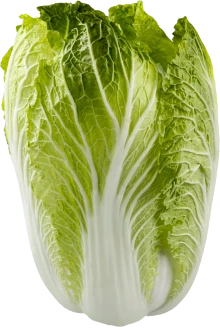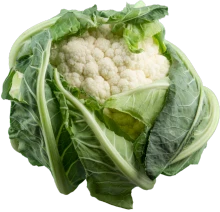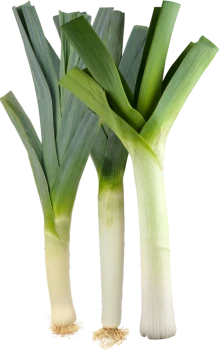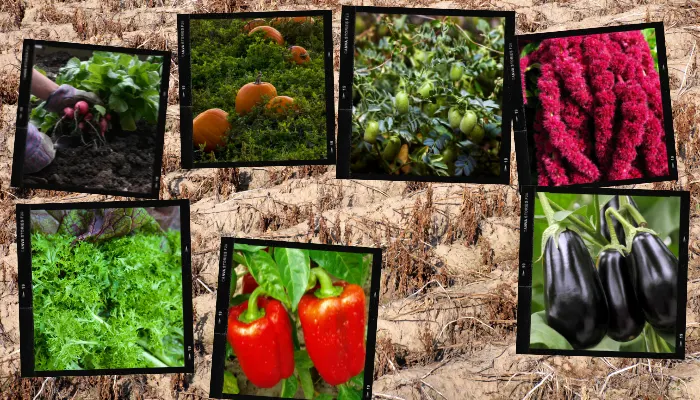Gardening enthusiasts often overlook the quiet potential of winter gardens, but, in truth, the cold onslaught brings an opportunity to cultivate a bountiful early spring harvest.
While your garden may seem dormant in the colder months, certain vegetables thrive when planted in winter. This approach ensures a rewarding harvest of fresh produce at a time when it’s most appreciated. Real quick, here’s a quick rundown of what this article is going to cover:
- The best vegetables to plant during winter for a fruitful spring harvest.
- Tips for successful winter gardening, even in challenging climates.
- How to extend your garden's productivity beyond the traditional growing season.
1. Spring Onions: A Winter Garden's Delight
Growing spring onions in winter sets the stage for an early spring harvest, filling your garden with freshness when it’s most needed.
These resilient plants can be sowed in late summer, around the 27th of August, for optimal growth. The key is to achieve a balance in their size before winter fully sets in.
Sowing and Growth:
- Ideal Timing: Sow your spring onions in late August. This timing ensures they’re neither too small to survive the winter nor too large to be damaged by frost.
- Growth Stage: Aim for medium-sized plants as winter approaches. They should be robust enough to withstand cold temperatures and wind, but not so large that they start to yellow or deteriorate.
Pest Management:
- Rabbit Threats: Keep an eye out for rabbit activity, as they tend to graze on young onion shoots. A mesh cover can be an effective deterrent if grazing becomes a significant issue.
- Maintaining Vigilance: Regular checks throughout winter will help you spot and address any pest-related damage early on.
The Rewards: As spring arrives, these onions will be among the first to offer their bounty. With proper care, you can expect a harvest as early as March, providing a welcome addition to your spring meals.
In the next section, we’ll explore another vegetable that thrives in the winter garden: endive.
2. Endive and Chervil: Winter's Flavorful Greens
Endive and chervil are two lesser known but highly rewarding plants to grow during winter. Their resilience to cold weather and unique flavors make them valuable additions to a winter garden.
Growing Endive:
- Sowing Endive: Plant endive in your garden during the early winter months. It thrives in colder temperatures, making it a perfect candidate for winter gardening.
- Care and Harvest: Endive requires minimal maintenance. As the weather begins to warm up in early spring, it will be ready to harvest, offering a crisp, slightly bitter green that is excellent in salads and cooked dishes.
Cultivating Chervil:
- A Delicate Herb: Chervil, a delicate herb like parsley, is ideal for winter cultivation. Its light, anise-like flavor makes it a fantastic addition to winter and early spring dishes.
- Planting Tips: Sow chervil seeds in late autumn or early winter. This herb prefers cooler temperatures and can even withstand light frosts, making it a suitable choice for a winter garden.
- Harvesting: You can start harvesting chervil as soon as it reaches a reasonable size. It’s a great herb for continuous cutting, regrowing quickly for multiple harvests throughout the winter and early spring.
In the next section, we’ll dive into the world of winter spinach, a robust and nutritious vegetable that offers both cold resistance and sweet, tender leaves.
3. Spinach: The Winter-Hardy Super Green
Sowing and Growing Spinach:
- Optimal Sowing Time: Plant spinach seeds around the 10th of August. This timing allows the plants to establish themselves before the harsher winter conditions set in.
- Climate Considerations: Adjust your sowing date based on your local climate. For example, gardeners in colder regions might need to sow as early as late July.
- Variety Matters: Choose a winter-hardy variety like ‘Medania’ for the best results. This variety is known for its resilience and flavor.
Winter Care and Spring Harvest:
- Managing Growth: Ensure your spinach plants are large enough to survive winter, but not so large that they bolt or become too mature.
- Sweetening Effect: As the colder months progress, the leaves of spinach tend to become sweeter. This is a delightful characteristic, as the plant uses natural sugars as a form of antifreeze.
- Harvesting: You can expect to start harvesting in late winter or early spring. Spinach planted in this manner can provide multiple pickings, extending your harvest season significantly.
Next, we will discuss cultivating cabbage for a spring harvest, focusing on the best sowing dates and care tips for overwintering this versatile vegetable.
4. Spring Cabbage: A Winter-to-Spring Delight
Cabbage planted in late summer or early autumn can yield a bountiful harvest in spring. This timing allows the plants to mature just right, avoiding issues like bolting or premature flowering.
Sowing and Growth:
- Ideal Sowing Time: For spring cabbage, the last week of August is a golden window. This allows the plants to establish themselves before winter.
- Growth Observation: By early December, the cabbages should be sizable but not yet forming heads. This state is perfect for overwintering, as it prevents premature heading and bolting.
Winter Care:
- Protection: Use a mesh cover to protect the young plants from pests like pigeons and from harsh winter winds.
- Leaf Maintenance: Regularly remove lower leaves that show signs of decay to prevent pest accumulation and promote healthy growth.
Harvesting:
- Early Spring Harvest: As the weather warms in spring, the cabbages will rapidly grow. You can start harvesting in March, removing every other one to allow the remaining plants to get even bigger.
- Continuous Harvest: This method provides a consistent supply of fresh cabbage leaves throughout the early spring.
Next up, we’re going to explore another winter-hardy vegetable, cauliflower. Plant it in winter, and you’ll have a full scale cauliflower harvest first thing in spring. And we all know how adaptable and useful cauliflower can be.
5. Cauliflower: A Winter Challenge with Spring Rewards
Cauliflower, while a bit more sensitive to winter conditions than cabbage, can be a successful addition to your winter garden with the right care.
Winter Care:
- Protection: Use mesh covers to safeguard young cauliflower plants from birds and harsh weather.
- Pest Management: Regularly inspect the plants for slug and caterpillar damage. Early intervention is crucial to maintain healthy growth.
- Leaf Care: Removing older, damaged leaves helps prevent pest buildup and keeps the plants healthy.
Anticipating the Harvest:
- Spring Expectations: With proper winter care, your cauliflowers should be ready to form heads in early spring. This timing coincides with the ‘hungry gap,’ making homegrown cauliflower a valuable addition to your kitchen.
- Cautious Optimism: Not all plants may survive the winter, but with attentive care, a significant portion should make it to harvest.
Next, we will look at broad beans, an often overlooked but super strong choice for late autumn sowing. And many gardeners aren’t aware of this one, so you’ll surprise and delight your friends.
6. Broad Beans: The Late Bloomers of the Winter Garden
Broad beans, when sown in late autumn, can offer a surprising yield in the late spring or early summer, providing a nutritious and hearty crop at a time when fresh produce is particularly welcome.
Sowing and Growing:
- Ideal Sowing Date: Sow broad beans around the 21st of October. This timing allows the plants to establish themselves before winter, but not grow too large to be susceptible to frost damage.
- Plant Growth: Ideally, the plants should be well-established but not overly tall or lush by the onset of winter, reducing the risk of damage from cold and wind.
Winter Maintenance:
- Monitoring Growth: Keep an eye on the plants’ size and health throughout the winter. If they become too large, they might be at risk of wind damage or frostbite.
- Protection Strategies: While broad beans are hardy, in harsher climates, a light cover or fleece may be beneficial to shield them from extreme conditions.
Spring Harvest:
- Anticipating Growth: As the weather warms up, the broad beans will start to grow more rapidly. They’re one of the first vegetables to be harvested in late spring or early summer.
- Harvest Strategies: You can harvest broad beans when they’re young and tender, or wait until they are fully mature for a more substantial crop.
And finally, we’re going to add one last vegetable to our winter garden list… leeks!
7. Leeks: The Stalwart of the Winter Garden
Leeks are an excellent choice for winter gardening, offering not only hardiness against the cold but also a flavorful addition to early spring meals.
Planting and Tending:
- Sowing Time: Plant leek seeds in late summer, around the end of August, to allow them ample time to develop before winter sets in.
- Growth Expectations: By early winter, your leeks should be well-established but not fully mature, making them capable of enduring the colder months ahead.
Winter Care:
- Cold Resistance: Leeks are naturally resistant to frost and can survive harsh winter conditions with little to no additional protection.
- Regular Checks: Periodically check your leeks throughout the winter for signs of pest infestation or weather damage, although they’re generally low maintenance.
Spring Harvest:
- Harvest Timing: As the weather begins to warm in early spring, leeks will quickly grow to harvest size. They can be harvested young for a tender flavor, or left to mature for a more robust taste.
- Versatility in Dishes: Leeks are a versatile vegetable in the kitchen, excellent in soups, stews, or as a side dish.
Conclusion
In this article, we’ve journeyed through the rewarding process of winter gardening, exploring a variety of vegetables and herbs that defy the cold to enrich your early spring harvest. From the resilience of spring onions and the hardiness of spinach to the robust growth of cabbage and leeks, we’ve seen how a winter garden can be both bountiful and diverse.
Here’s a quick recap of the key takeaways:
More To Discover
- Seasonal Adaptation: Winter gardening isn’t just about enduring the cold; it’s about using the season to your advantage, growing vegetables and herbs that thrive in cooler temperatures.
- Early Harvest Rewards: By planting in winter, you ensure an early spring harvest, offering fresh produce during a time when it’s most scarce and appreciated.
- Gardening Resilience: The vegetables and herbs discussed demonstrate that with the right care and timing, your garden can be productive year-round.
As you prepare your garden for winter, remember that this quiet season can be a time of great anticipation and preparation for the abundance of spring. Embrace the challenge and enjoy the unique rewards of winter gardening.
For your next step, consider exploring companion planting to enhance your winter garden or delve into organic pest control methods to ensure a healthy, thriving garden.







